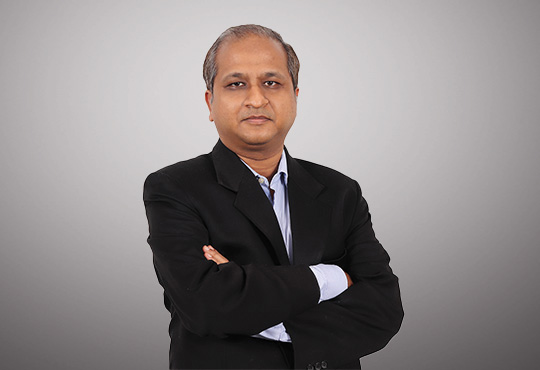The Power and Pitfalls of Influencer Marketing and How Brands Can Win Amid Distrust
 Saurabh Gupta, Group CIO, SAR Group in an interaction with Higher Education Review Magazine shared his views on why influencer marketing has become a central part of brand strategy, how technology is changing influencer marketing, biggest challenges brands face with influencer marketing today and more.
Saurabh Gupta, Group CIO, SAR Group in an interaction with Higher Education Review Magazine shared his views on why influencer marketing has become a central part of brand strategy, how technology is changing influencer marketing, biggest challenges brands face with influencer marketing today and more.
Saurabh Gupta, Group CIO at SAR Group, leads IT strategy across diverse sectors with over 20 years experience. A certified digital transformation leader, he excels in IT business strategy, consulting, and driving innovation to enhance customer satisfaction, operational efficiency, and business growth through advanced digital solutions.
Why has influencer marketing become such a central part of brand strategy?
Influencer marketing taps into something that traditional advertising often struggles with — human connection. Today’s audiences are not just buying products; they’re buying trust, relatability, and shared values. An influencer, whether a celebrity with millions of followers or a micro-creator with a tightly knit community, offers brands a direct channel to these audiences. Instead of delivering a generic message to the masses, influencer marketing allows a brand to speak in a familiar voice to an audience that already trusts the messenger. This targeted, human-first approach often delivers better engagement and stronger conversion than even the most well-funded ad campaigns.
What kinds of influencers should brands be looking at?
It’s tempting to chase big follower counts, but brands are increasingly finding value in smaller, niche-focused influencers — those with 5,000 to 20,000 followers — because their communities are more engaged and their recommendations feel personal. Mega-influencers can create mass awareness, but micro- and nano-influencers often drive higher-quality interactions and stronger loyalty. The choice depends on the campaign goal: broad visibility or deep engagement.
How is technology changing influencer marketing?
The process of finding, vetting, and collaborating with influencers has become far more data-driven. Brands now use AI-driven platforms to identify influencers whose audiences match the target demographic, predict campaign performance, and even assess authenticity by analyzing audience behavior. Beyond selection, technology enables real-time tracking of campaign impact, allowing marketers to adjust messaging, platforms, and influencer mix on the fly. However, while technology is essential for scale and precision, the emotional, human element of storytelling still remains at the core.
What are the biggest challenges brands face with influencer marketing today?
One of the most pressing challenges is authenticity — or rather, the lack of it. The rise of fake followers, inflated engagement metrics, and even AI-generated influencers has made it harder for brands to separate genuine voices from fabricated personas. Some influencers buy followers or use engagement pods to artificially boost their numbers, creating a misleading picture of their true reach and influence. This not only wastes marketing budgets but also damages brand credibility when audiences sense insincerity.
How does influencer fraud hurt genuine marketers and creators?
Fraudulent influencers divert budgets away from authentic creators who have built their communities through genuine effort. When brands get burned by fake metrics or underperforming campaigns, they often become more cautious or cut spending on influencer marketing altogether. This hurts the real, hard-working influencers who consistently deliver value. Over time, the erosion of trust impacts the entire ecosystem — audiences start doubting influencer recommendations, brands hesitate to invest, and genuine voices struggle to get noticed in a sea of manufactured popularity.
How can brands protect themselves from influencer fraud?
Brands need to implement a layered verification process. This includes manually reviewing audience quality, looking beyond follower counts, analyzing comment patterns, and checking for sudden spikes in engagement that may indicate manipulation. Long-term partnerships also help, as they allow brands to see consistent performance over time rather than relying on one-off campaigns. Collaborating with influencers who align with brand values, rather than those who simply fit a demographic profile, also reduces risk — authenticity is harder to fake over a sustained relationship.
How can brands ensure influencer partnerships feel organic to audiences?
The partnership should never feel like an interruption. Instead of dictating the exact words or creative direction, brands should allow influencers the freedom to tell the story in their own voice. This means trusting them to know what resonates with their audience. When an influencer’s audience feels the content reflects their genuine opinion rather than a scripted ad, the campaign earns credibility—and often, better results.
What’s the future of influencer marketing in the next 3–5 years?
We’ll likely see a blend of high-tech and high-touch. AI will continue to refine influencer discovery and performance tracking, but the human element will be the differentiator. Video-first platforms will dominate, community-driven content will gain more importance, and long-term brand–influencer collaborations will outpace one-off deals. At the same time, regulations around disclosure and authenticity will tighten, making transparency not just a best practice, but a compliance requirement. Brands that embrace authenticity, invest in relationships, and leverage technology without losing the personal touch will be the ones to thrive.

.jpg)